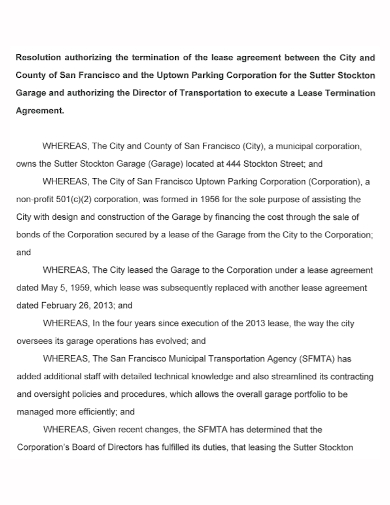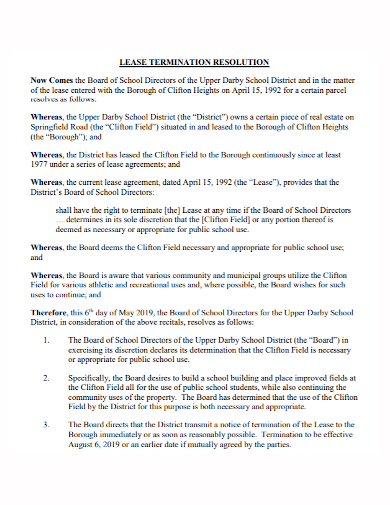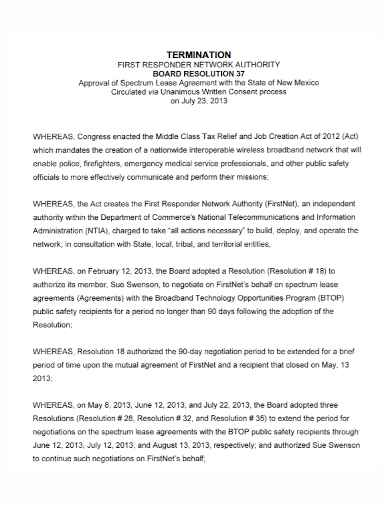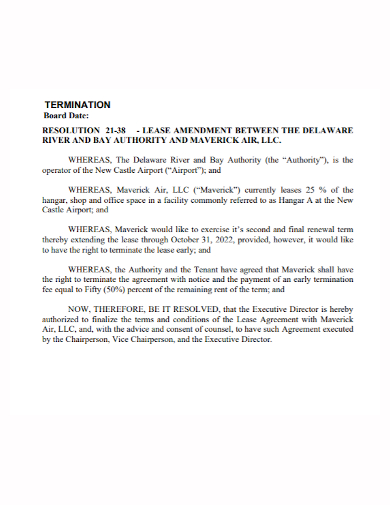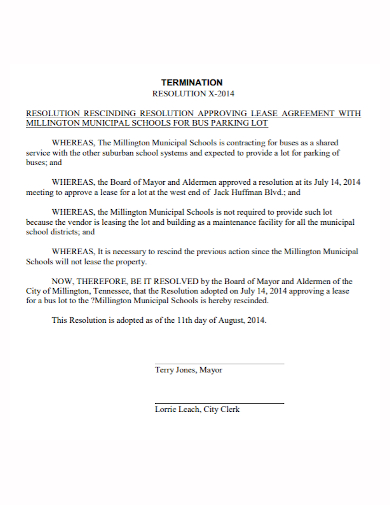A lease is a contract between two or more parties that requires them to abide by the terms and circumstances of the agreement. A tenant may be required to vacate a rental unit before the end of the rental agreement or lease for a variety of reasons after signing the rental agreement or lease. In a similar vein, the landlord has the authority to terminate the lease under specific situations. Providing written notice of intent to terminate a lease must adhere to both state and lease requirements and the terms of the lease in order to be effective.
Because a lease is a legally binding contract, tenants are required to remain in their rental property for the life of the lease. In other words, they are obligated to pay rent for as long as the contract is in effect. There are several exceptions to this rule, particularly in the case of a landlord who breaches or violates the lease agreement. For example, some states provide explicit reasons for renters to break their leases, such as military service or domestic violence situations.
Depending on the circumstances, a tenant may be able to move out without giving notice, or with less notice than is generally required, if the landlord violates the lease’s requirements, particularly health and safety regulations. Constructive eviction is the legal term used to describe this situation, which means that the tenant is essentially evicted from the property since the rental premises are uninhabitable. Similarly, if the renter is unable to remain in the rental property due to a natural disaster or significant damage to the rental unit, the situation may arise. The landlord, on the other hand, has the right to sue the tenant for damages if the tenant violates the lease agreement without a legally justified reason.
If a tenant fails to comply with the terms of the lease or infringes the law, the landlord has the legal right to cancel the lease agreement without notice. The tenant’s infringement must be substantial, such as failing to pay rent on time or possessing a dog despite the fact that canines are not permitted on the property. When a landlord finds that a tenant has violated the law, such as by selling drugs on the premises, he has adequate reasons to terminate the lease.
The landlord must first provide the tenant with a written notice of termination that clearly says that the tenancy has come to an end. The terms of the notice, as well as the conditions under which it must be delivered, vary from state to state. Depending on the circumstances, further time may be granted to the renter to cure the infringement, for as by paying past-due rent. Alternatively, the notice could state that the renter must vacate the premises immediately or else face eviction from the property.
How to construct a proper and effective lease termination agreement will be discussed in detail in this article. Take a look at the board resolution for termination of lease agreement samples that we’ve provided for you below to get a sense of what we’re talking about. After becoming familiar with the document, its appearance, and general operation, feel free to use these samples as guides or even as templates when you begin developing your own version of the document from scratch.
10+ Board Resolution for Termination of Lease Agreement Samples
1. Board Resolution for Termination of Lease Agreement Template
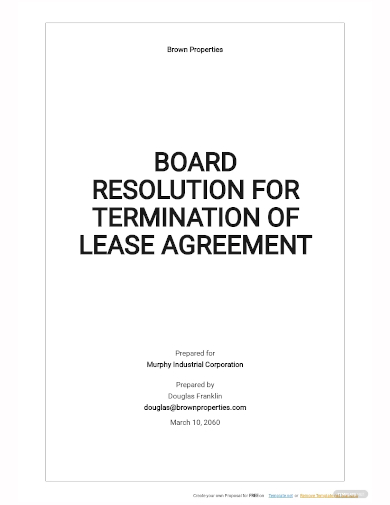
2. Board Resolution for Termination of Lease Agreement
3. Board Resolution Execute for Termination of Lease Agreement
4. School Board Resolution for Termination of Lease Agreement
5. Board Memo Resolution for Termination of Lease Agreement
6. Board Resolution for Termination of Lease Property Agreement
7. Board Authority Resolution for Termination of Lease Agreement
8. Board Resolution for Mutual Termination of Lease Agreement
9. Sample Board Resolution for Termination of Lease Agreement
10. Board Director Resolution for Termination of Lease Agreement
11. Board Resolution Approving for Termination of Lease Agreement
What Is a Board Resolution for Termination of Lease Agreement?
In order to terminate a lease agreement early or certify that a lease term that is about to expire will not be renewed, both landlords and tenants must use a Lease Termination Letter. A lease agreement can be completed and handed to the opposing party by either of the parties involved. If you need to end your lease early, the majority of lease agreements require you to provide written notice within a specific number of days. Even though your lease contract does not specifically require it, the use of a lease termination letter may be useful to you in the event of a subsequent conflict with your landlord. It is common practice for landlords and tenants to exchange lease termination letters at the end of a lease period in order to avoid any misconceptions about when the property will be available for occupation. The use of a lease termination letter is common when a property owner wants to sell or renovate their property, or when they are displeased with their current tenant. This paper can also be used by landlords if they want to raise the rent but the present tenant does not want to renew under the new terms.
Elements of a Board Resolution for Termination of Lease Agreement
- Check the terms on the lease agreement
Consider the type of rental agreement you have, as well as the information contained within it, before proceeding with the process of terminating your lease. It is in your Lease Agreement that you will find a list of the obligations and rights that both the landlord and the renter have agreed to. Here are some examples of typical leases that you might encounter:- Standard Lease
- Month-to-Month Lease
- Sublease Agreement
- Name the parties involved
The names and addresses of all of the parties involved in the issue must be included in the termination letter sent by a landlord to his or her renter. Identify the landlord and tenant, i.e., the person who owns the property and the party that is renting the property, by making a note of their names. - Reference the original rental agreement
Specify in this section of the form when the original lease/rental agreement was signed by the landlord and the renter, as well as when the lease will come to an end. - Fill the vacate date
The date on which the tenant is scheduled to vacate the premises should be entered here. There are two possibilities for this date: (1) before the lease term’s expiration, or (2) at or near the end of the lease term’s conclusion. - Reason for termination
The reason for termination is a crucial section of the letter, and it is here that you should explain why you desire to leave your current position. If you terminate your employment in error, you may face legal repercussions; therefore, it is recommended that you provide an explanation for your decision in your notice to avoid any confusion later. - Include a forwarding address
Make a note of where you want to mail, future notices, and your security deposit delivered. - Proof of service
You will be required to present a signed Affidavit of Service if you were not the person who served the termination notice. The notification is then delivered to the designated receiver, which could be either the landlord or the tenant. This affidavit proves that the notification was received by the party in dispute on a specific date.
Tips for Writing a Board Resolution for Termination of Lease Agreement
- Proofread
To confirm that the information is right, please double-check the dates and spelling. - Keep it clear and concise
Include a detailed explanation of why you decided to leave your job. Most leases, for example, allow a tenant to depart early if the premises are uninhabitable and the landlord has failed to make the necessary repairs. - Check the lease for where and how to deliver your letter
Leases typically specify where you must provide notice, as well as how you must deliver your letter. - Don’t sit on it
Once you’ve decided to break your lease early, you should write and deliver your lease termination letter to the landlord as soon as feasible. If you opt to dissolve the agreement early, it is advisable to give the other party as much notice as possible.
FAQs
What are the types of lease?
The most common types of leasing are the absolute net lease, triple net lease, modified gross lease, and full-service lease, which are all variations on the net lease. Tenants and company owners should read the terms and conditions of a lease agreement carefully before signing it.
What is the difference between lease and rent?
The most important distinction between a lease and a rental agreement is the duration of validity. A rental agreement is typically for a short period of time (typically 30 days), whereas a lease agreement is for a longer period of time (generally 12 months, although 6 and 18-month leases are also frequent).
What are some disadvantages of leasing?
- Expensive in the long run
- Limited mileage
- High insurance cost
- Confusing
- Hard to cancel
- Requires good credit
- Lots of fees
- No customizations
When it comes to terminating a rental, it’s important to look over your contract, local laws, and your individual circumstances. A local landlord-tenant lawyer can assist you to understand your rights and walk you through the process of terminating a lease or rental agreement, which is the best way to get answers to any questions you might have.
Related Posts
Sample Business Agreement between Two Parties
FREE 9+ Shop Rental Agreement Samples [ Commercial, Lease, Tenancy ]
FREE 10+ Charter Agreement Samples In MS Word | Google Docs | Apple Pages | PDF
FREE 10+ Mentoring Agreement Samples In MS Word | Apple Pages | PDF
FREE 10+ Partner Agreement Samples In MS Word | Google Docs | Apple Pages | PDF
FREE 10+ Individual Agreement Samples In MS Word | Google Docs | Apple Pages | PDF
FREE 10+ Strategic Agreement Samples In MS Word | Google Docs | Apple Pages | PDF
FREE 10+ Equity Agreement Samples In MS Word | Google Docs | Apple Pages | PDF
FREE 10+ Producer Agreement Samples in MS Word | Apple Pages | PDF
FREE 10+ Grant Agreement Samples In MS Word | Apple Pages | PDF
FREE 8+ Meeting Agreement Samples in MS Word | Google Docs | Apple Pages | PDF
FREE 10+ Community Agreement Samples In MS Word | Google Docs | PDF
FREE 8+ Real Estate Option Agreement Samples in MS Word | PDF
FREE 10+ Call Option Agreement Samples In MS Word | PDF
FREE 10+ Advertising Agreement Samples In MS Word | Google Docs | Apple Pages | PDF

